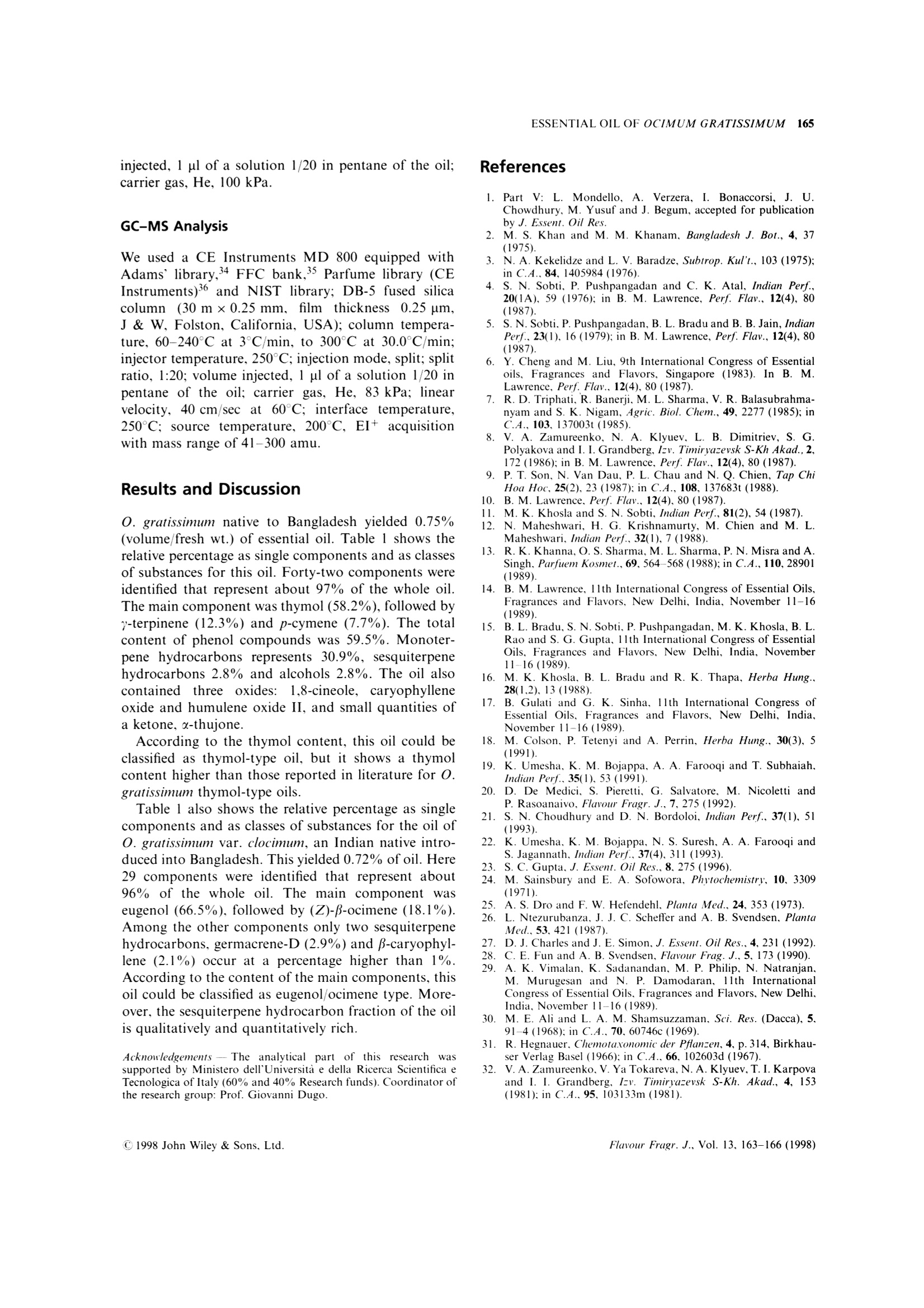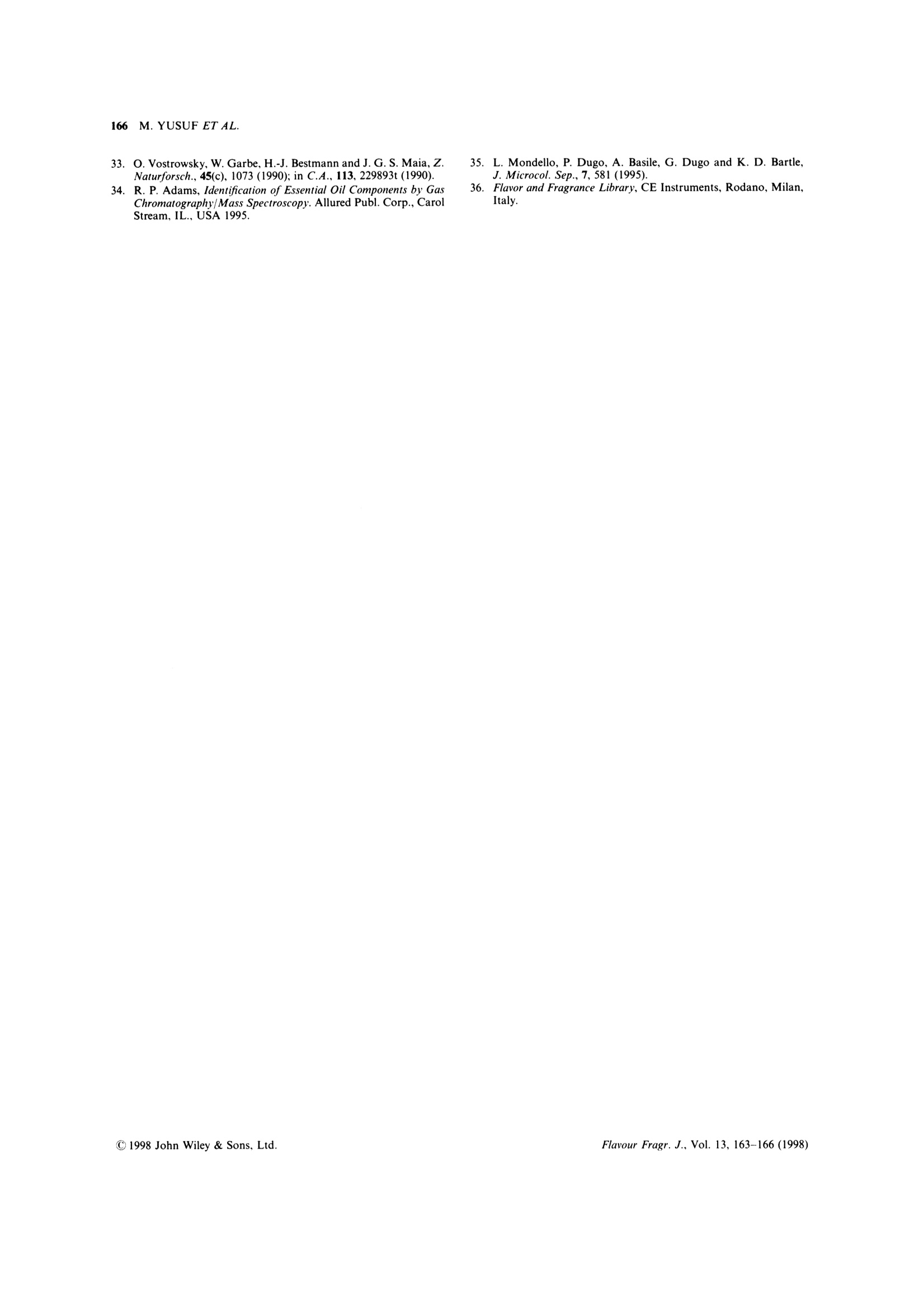
essential oil of ocimum gratissimum L. obtained from plants originating from bangladesh and from plants introduced into bangladesh....
方案详情

FLAVOUR AND FRAGRANCE JOURNALFlavour Fragr. J.. 13, 163-166 (1998) 164 M. YUSUF ET AL. Studies on the essential oil bearing plants ofBangladesh. Part VI. Composition of the oilofOcimum gratissimum L.t Mohammed Yusuf,1 Jaripa Begum,Luigi Mondello2* and Ildefonsa Stagno d'Alcontres2 'BCSIR Laboratories, P.O. Chittagong Cantonment, Chittagong 4220, Bangladesh 2Dipartimento Farmaco-Chimico, Facolta di Farmacia, Universita di Messina, Viale Annunziata, 98168 Messina, Italy Received 22 March 1997 Accepted 4 July 1997 ABSTRACT: The composition of the essential oil of Ocimum gratissimum L. obtained from plants originatingfrom Bangladesh and from plants introduced into Bangladesh from India is reported. The oil obtained fromplants native of Bangladesh can be classified as thymol-type according to its thymol content (58.2%), while theoil obtained from plants introduced from India can be classified as eugenol/ocimene type according to its contentof eugenol (66.5%) and ocimenes (18.9%). C 1998 John Wiley & Sons, Ltd. KEY WORDS: Ocimum gratissimum L.;essential oil composition; cchemotypes;gas chromatography;GC-MS: thymoll;; eugenol;ocimene Introduction Ocimum gratissimum L. (shrubby basil) is a tall, much-branched perennial shrub, 1-2.5 m high, distributed inthe tropical areas of Africa,America and Asia. In theIndian subcontinent it is found in the peninsular India(West Bengal and Assam) and in Bangladesh. The oils distilled from O. gratissimum are character-ized, generally, by their high phenol content, consistingmainly of eugenol3-23 or thymol.24-26 Other chemotypesare also reported: a linalol type; 4 a geraniol type;7 amethyl cinnamate and a eugenol/sesquiterpene type;an ocimene type, an ocimene/methyl isoeugenol typeandl aa eugenol/ocimene type; an ethyl cinnamatetype,30 a citral type;3l a sesquiterpene type;32 a eugenol/methyl eugenol type.33 In the eugenol type, the eugenolcontent ranges from 18% to 90%; while in the thymoltype the thymol content ranges from 19%25 to 48%24. In this paper the composition of the essential oil ofO. gratissimum isolated from the plants originatingfrom Bangladesh and identified by Khan and Khanamand the oil from the plants of O. gratissimum var.clocimum evolved in India by Sobti and introducedinto Bangladesh in 1986 is reported. ( "Correspondence t o: L uigi M ondello, D ipartimento F armaco-Ch i mico. Facolta di Farmacia. U n iversita di Messina, Viale Annunziata,98168 M e ssina,Italy. + For P art V s ee R ef.1. Contract grant sponsor: M i nistero dellUni v ersita e d e lla R i cerca S c ientifica e Tecnologica, Italy. ) Experimental The leaves andtheeinflorescenceseswere collectedfrom the plants grown in the campus of BangladeshCouncil of Scientific and Industrial Research (BCSIR)Laboratories, Chittagong duringgsSeptember 11995(O. gratissimum var. clocimum)anddMay11996(Bangladeshian O. gratissimum). The oils were isolatedfrom the fresh leaves and inflorescences by hydro-distillation carried out for 2 hours in a modifiedClevenger-type apparatus. Voucher samples of O. gratissimum originating fromBangladeshare retained inBangladesh NationalHerbarium. Dhaka:while voucher samplesoiO. gratissimum evolved in India are retained in theHerbarium of the Regional Research Laboratories,CSIR, Jammu-Tawi. Both are also retained in theHerbarium of BCSIR Laboratories, Chittagong. GC Analysis We used a Fisons chromatograph 5160 Mega Seriesequipped with a Shimadzu data processor C-R 3A; anSE-52 fused silica column (25 m ×0.32 mm, film thick-ness 0.40-0.45 um, Mega, Legnano, Italy); columntemperature, 40°C (6 min) to 240℃ at 3.0°C/min;injector temperature, 250C; detector temperature,280°C; injection mode, split; split ratio, 1:50; volume Table 1. Relative percentage as single components and as classes of substances for the oil of Ocimum gratissimum L.native to Bangladesh (A) and of Ocimum gratissimum L. var. clocimum introduced into Bangladesh from India (B) a. Adam’s library: b. Parfume library:c. FFC bank, co-injection with authentic compounds: d,NIST library: nd, not determined injected, 1 pl of a solution 1/20 in pentane of the oil;carrier gas, He, 100 kPa. GC-MS Analysis We used a CE Instruments MD 800 equipped withAdams’ library,34 FFC bank,35 Parfume library (CEInstruments)3and NIST library; DB-5 fused silicacolumn (30 m ×0.25 mm. film thickness 0.25 um,J & W, Folston, California, USA); column tempera-ture, 60-240°C at 3C/min, to 300℃ at 30.0°C/min;injector temperature, 250℃; injection mode, split; splitratio, 1:20; volume injected,1 pl of a solution 1/20 inpentane of the oil; carrier gas, He, 83 kPa; linearvelocity, 40 cm/sec at 60°C; interface temperature,250°C; source temperature, 200℃, EI+ acquisitionwith mass range of 41-300 amu. Results and Discussion O. gratissimum native to Bangladesh yielded 0.75%(volume/fresh wt.) of essential oil. Table 1 shows the)01relative percentage as single components and as classesof substances for this oil. Forty-two components wereidentified that represent about 97% of the whole oil.The main component was thymol (58.2%), followed byy-terpinene (12.3%) and p-cymene (7.7%). The totalcontent of phenol compounds was 59.5%. Monoter-pene hydrocarbons represents 30.9%, sesquiterpenehydrocarbons 2.8% and alcohols 2.8%. The oil alsocontained three oxides:1,8-cineole, caryophylleneoxide and humulene oxide II, and small quantities ofa ketone, a-thujone. According to the thymol content, this oil could beclassified as thymol-type oil, but it shows a thymolcontent higher than those reported in literature for O.gratissimum thymol-type oils. Table 1 also shows the relative percentage as singlecomponents and as classes of substances for the oil ofO. gratissimum var. clocimum, an Indian native intro-duced into Bangladesh.This yielded 0.72% of oil. Here29 components were identified that represent about96% of the whole oil. The main component waseugenol (66.5%), followed by (Z)-B-ocimene (18.1%).Among the other components only two sesquiterpenehydrocarbons, germacrene-D (2.9%) and B-caryophyl-lene (2.1%) occur at a percentage higher than 1%.According to the content of the main components, thisoil could be classified as eugenol/ocimene type. More-over, the sesquiterpene hydrocarbon fraction of the oilis qualitatively and quantitatively rich. ( A cknowledgements - T h e analytical p a rt of th i s r e s earch w a s supported b y M i n istero dellUnive r sita e della Ricerca Scie n tifica e T ecnologica of Ital y (6 0% and 40 % R esearch f unds). Coordinator of t he research group: Prof. Giovanni D ugo. ) References 1. Part V: L. Mondello, A. Verzera, I. Bonaccorsi, J. U.Chowdhury, M. Yusuf and J. Begum, accepted for publicationby J. Essent. Oil Res. 2.. M. S. Khan and M. M. Khanam. Bangladesh J. Bot., 4, 37(1975). 3.N. A. Kekelidze and L. V. Baradze, Subtrop. Kul’t., 103(1975);in C.A., 84、1405984(1976). 4.S. N. Sobti, P. Pushpangadan and C. K. Atal, Indian Perf.,20(1A), 59 (1976); in B. M. Lawrence, Perf. Flav., 12(4), 80(1987). 5S.N. Sobti. P. Pushpangadan, B. L. Bradu and B. B. Jain, IndianPerf.23(1), 16(1979); in B. M. Lawrence, Perf. Flav., 12(4), 80(1987). 6.Y. Cheng and M. Liu, 9th International Congress of Essentialoils, Fragrances and Flavors, Singapore (1983). In B. M.Lawrence, Perf. Flav..12(4),80(1987). 7.R. D. Triphati, R. Banerji, M. L. Sharma, V. R. Balasubrahma-nyam and S. K. Nigam, Agric. Biol. Chem., 49, 2277(1985); inC.A., 103.137003t (1985). 8.V. A. Zamureenko, N. A. Klyuev, L. B. Dimitriev, S. G.Polyakova and I. I. Grandberg, Izv. Timiryazevsk S-Kh Akad.,2.172(1986); in B. M. Lawrence, Perf. Flav.,12(4),80(1987). 9.P. T. Son, N. Van Dau, P. L. Chau and N. Q. Chien, Tap ChiHoa Hoc, 25(2),23 (1987); in C.A., 108,137683t (1988). B. M. Lawrence, Perf. Flav., 12(4), 80 (1987). . N. Manesola ana. . nshnamfien Pe. chhen and’Maheshwari,Indian Perf., 32(1), 7(1988). 13..R. K. Khanna,O. S. Sharma, M. L.Sharma, P. N. Misra and A..neSingh, Parfuem Kosmet., 69,564-568 (1988); in C.A., 110, 28901(1989). 14..B. M. Lawrence, 1lth International Congress of Essential Oils,Fragrances and Flavors, New Delhi, India, November 11-16(1989). 155.B. L. Bradu, S. N. Sobti, P. Pushpangadan, M. K. Khosla, B. LRao and S. G. Gupta, 11th International Congress of EssentialOils, Fragrances and Flavors, New Delhi, India, November11-16 (1989). 16..M. K. Khosla, B. L. Bradu and R. K. Thapa, Herba Hung.,28(1.2), 13(1988). 17..B. Gulati and G. K. Sinha, llth International Congress ofEssential Oils, Fragrances and Flavors, New Delhi, India,November 11-16 (1989). 188.M. Colson, P. Tetenyi and A. Perrin, Herba Hung., 30(3), 5(1991). 19..K. Umesha, K. M. Bojappa, A. A. Farooqi and T. Subhaiah.Indian Perf.. 35(1), 53 (1991). 0.D. De Medici.S. Pieretti.G. Salvatore, M. Nicoletti andP. Rasoanaivo, Flavour Fragr. J., 7, 275(1992). 21.S1. N. Choudhury and D. N. Bordoloi, Indian Perf, 37(1), 5I(1993). 22K. Umesha. K. M. Bojappa,N. S. Suresh,A. A. Farooqi andS. Jagannath, Indian Perf., 37(4),311(1993). S. C. Gupta, J. Essen1. Oil Res., 8. 275 (1996). M. Sainsbury and E. A. Sofowora, Phytochemistry, 10, 3309(1971). . A. S. Dro and F. W. Hefendehl, Planta Med.,24, 353(1973). . L. Ntezurubanza. J. J. C.Scheffer and A. B. Svendsen. PlantaMed.,53.421(1987). D. J. Charles and J. E. Simon, J. Essent. Oil Res., 4, 231 (1992).. C. E. Fun and A. B. Svendsen, Flavour Frag. J., 5,173 (1990) M. Murugesan and ndanp. pamodaran. nih interationatCongress of Essential Oils, Fragrances and Flavors, New Delhi,India. November 11-16 (1989). 300.M. E. Ali and L. A. M. Shamsuzzaman, Sci. Res.(Dacca), 591-4(1968); in C.A., 70,60746c (1969). ( 31 . R. Hegnauer, C h emotaxonomic de r Pflanzen, 4 . p.314, B i r khau- s er Verlag B asel ( 1966); in C .A ., 66,102603d(1967). ) ( . 32 2 . V . A . Zamureenko, V. Ya T o kareva,N. A. K l yuev, T . I. K arpovaand I .I . G randberg, Izv. T imiryazevsk S-Kh. Akad., 4, 153( 1 981); in C .A . , 95, 103133m (1981). ) 166 M.YUSUF ET AL. ( 33. O . Vostrowsky, W. Garbe, H. - J. Bestmann and J. G. S. Maia, Z.Naturforsch., 45(c), 1073 (1990); in C.A., 113, 229893t (1990). ) ( 35 .L . M ondello, P. D ugo, A. Basile, G. Dugo a nd K. D. Bartle, J . Microcol. S ep., 7, 581 (1995). ) 34. R1. P. Adams, Identification of Essential Oil Components by GasChromatography/Mass Spectroscopy. Allured Publ.Corp., CarolStream, IL., USA 1995. 36.5.Flavor and Fragrance Library, CE Instruments, Rodano, Milan,Italy. CCC C John Wiley & Sons, Ltd.. Flavour Fragr. J.. Vol. (
确定




还剩2页未读,是否继续阅读?
扬州华明仪器设备有限公司为您提供《丁香罗勒精油中成分分析检测方案 》,该方案主要用于日用化学品/香精香料中成分分析检测,参考标准--,《丁香罗勒精油中成分分析检测方案 》用到的仪器有
相关方案
更多







